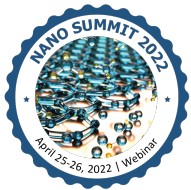
Dr. Khairul Habib
Universiti Teknologi Petronas Malaysia
Title: Improved thermophysical properties and energy efficiency of aqueous ionic liquid/MXene nanofluid in a hybrid PV/T solar system
Biography
Biography: Dr. Khairul Habib
Abstract
In this research, a binary solution of ionic liquid (IL) + water based ionanofluids are formulated successfully with two dimensional MXene (Ti3C2) nano additives at three distinct concentrations of 0.05, 0.10 & 0.20 weight%. The layered structure of MXene and high absorbance of prepared nanofluids have been perceived by SEM and UVVis respectively. Rheometer and DSC are used to assess the viscosity and heat capacity respectively while transient hot wire technique is engaged for thermal conductivity measurement. After characterization of ionanofluids, a numerical study is executed in a PV/T solar system with optimum concentration of 0.20%. Maximum 47% improvement in thermal conductivity is observed for 0.20 wt% loading of MXene. Meanwhile, specific heat is noticed to rise consistently as temperature and concentration increase for each sample. More explicitly, as the temperature is increased from 25 to 60 ºC specific heat augments from 2.4 to 2.53 J/g.K for 0.20 wt% of Ti3C2. Furthermore, the viscosity rises from 2.69 to 2.99 mPa.s with addition of Ti3C2 by 0.05 wt%, while for 0.10 and 0.20 wt%, viscosity further increases to 3.01 and 3.06 mPa.s respectively. Conversely, viscosity decreases substantially as the temperature increases from 20 to 60 ºC. A comparative analysis in terms of heat transfer performance with three different nanofluids in PV/T system shows that, IL+ water/MXene ionanofluid exhibits highest thermal, electrical and overall heat transfer efficiency compared to water/alumina, palm oil/MXene and water alone. Maximum electrical efficiency and thermal efficiency are recorded as 13.95% and 81.15% respectively using IL + water/MXene, besides that, heat transfer coefficients are also noticed to increase by 12.6% and 2% when compared to water/alumina and palm oil/MXene respectively. In conclusion, it can be demonstrated that MXene dispersed ionanofluid might be great a prospect in the field of heat transfer applications since they can augment heat transfer rate considerably which improves system efficiency.

